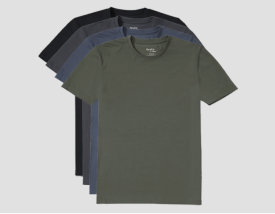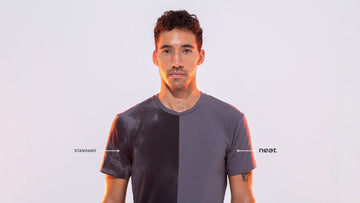“Comfort” seems elusive, if not, impossible when you live with excessive sweating. Nothing is more frustrating than feeling wet, sticky, and itchy when you should feel calm and collected. Fortunately, the use of moisture-wicking fabrics can reduce the uncomfortable dampness that excessive sweating causes. How so? This post will breakdown the science of moisture-wicking and highlight the most effective, moisture-wicking fabrics.
How Moisture Wicking Works
Moisture-wicking fabrics are composed of poly fibers that draw moisture through the process known as “capillary action”. During this process, the poly fibers pull moisture away from the body and capture it in the fabric, where it dries faster than it would on the skin.
Next, the moisture reaches the outermost layers of the fabric and disperses within it. The sweat then evaporates from the surface of the fabric leaving it relatively dry. The benefit of this moisture-wicking action is that it allows you to stay dryer, faster. Also, fast evaporation means a reduction in the appearance of sweat stains.
Best Moisture-Wicking Fabrics
Some fabrics have a natural moisture-wicking ability even though they’re not specifically designed or branded for that purpose. However, their natural composition mimics the capillary action of moisture-wicking fabrics, allowing excess sweat to dissipate fast.
An article featured on CoolHikingGear.com ranked six different types of fabrics’ on how well they wicked moisture. Number one was the most effective while number six was the least. Here's a look at these rankings.
The Most Effective Moisture-Wicking Fabrics
If you want true moisture-wicking action from your clothing, then you’ll need to add sweat-resistant fabrics (and apparel for excess sweating) to your wardrobe. They’re more effective than traditional store-bought fabrics. For example, our line of NEAT Apparel undershirts is specifically formulated with material and mesh patterns that accelerate moisture absorption and moisture-wicking. This makes our line of sweatproof undershirt ideal if you suffer from hyperhidrosis.
Importance of Staying Dry With Apparel for Excess Sweating
Don’t make the effort to stay dry something to take lightly. Tackling hyperhidrosis goes a long way in maintaining your comfort, confidence, and health.
Sweat Resistant Fabrics Bring You Comfort
We’ll assume you don’t like to feel unnecessarily wet and sticky. This is especially true when you are in a professional or casual setting, instances where comfort has a direct impact on how you interact with others. The sensation of being wet and sticky alone is enough to drive you crazy and distract you from a conversation or task. Wearing a sweat-proof undershirt or some other sweat-resistant fabric can restore a sense of comfort.
Sweat Resistant Fabrics Improve Your Appearance
It's one thing to feel sweaty - it's another thing to look it. If you're walking around with massive sweat stains at your armpits, it can make you feel self-conscious and distract those you’re talking to. Sweat-resistant fabrics, especially dark-colored ones, hide large sweat stains. This does wonders for your confidence in social and professional settings.
Sweat Resistant Fabrics Can Affect Your Health
Maybe you never thought of it this way, but staying dry actually is important for your health. In another article, we discussed how excessive sweating can lead to skin disorders. When you're constantly soaked from sweat, you will start to experience changes in the texture of your skin. This can lead to uncomfortable and unsightly ailments such as maceration. For the sake of your skin's health, prevention is better than cure and that means you should make efforts to keep excessive sweating at bay. A sweatproof undershirt can eliminate much of the moisture that clings to your skin, giving it the chance to stay dry and heal from hyperhidrosis-induced damage.
Wet or Dry: You Are What You Wear
Although hyperhidrosis has a wide range of available treatments, one of the most effective ways to keep sweating under control is by choosing the right fabrics. Moisture-wicking and sweat-resistant fabrics keep you feeling dry and comfortable for all sorts of settings including casual and professional ones. If you haven't already considered sweat-resistant fabrics, then wait no more. They might be the quick and easy hyperhidrosis solution you've been looking for all along!








